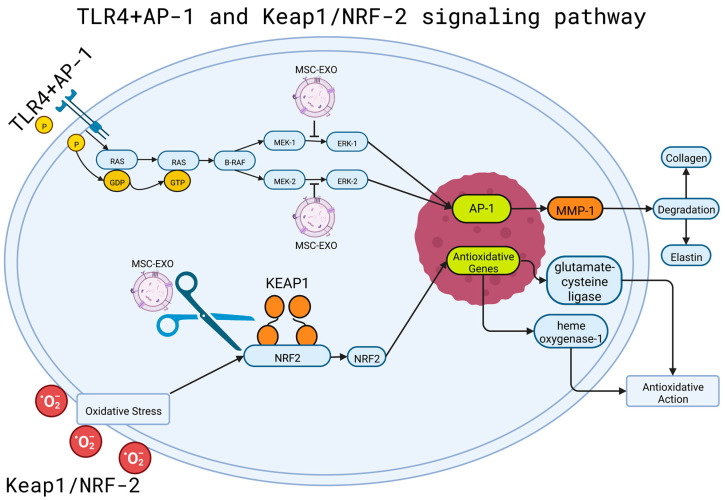Figure 5.
TLR4 + AP-1 and keap1/NRF-2 mechanisms of action and stem cell disruption. Shown in the top portion is the MAPK pathway, which activates and phosphorylates proteins. A Ras molecule is energized, exchanging its original GDP molecule with GTP, activating the protein. The activated Ras binds to B-Raf, an effector protein, which gives energy to MEK 1 and 2 via phosphorylation, and, in turn, phosphorylates ERK 1 and 2. This can lead to the activation of the AP-1 factors Fos and Jun. Once activated, the factors bind to an AP-1 receptor in a chain of DNA, leading to the expression of different genes and the production of MMP-1, which causes the degradation of elastin and collagen. MSC-EXO can be used to interrupt the activation of ERK 1 and 2, inhibiting the activation of AP-1 and, in turn, the degradation of elastin and collagen. The bottom portion shows the NRF2-KEAP1 pathway, triggered by oxidative stress. Traditionally, NRF2 and KEAP1 regulate each other, leading to the production of anti-inflammatory factors in response to oxidation. MSC-EXO can sever the connection between the two molecules, disrupting the production of anti-inflammatory factors. AP-1: Activating Protein-1; B-RAF: B subunit proto-oncogene serine/threonine-protein kinase; ERK-1/2: Extracellular signal-regulated kinase 1/2; GDP: Guanosine diphosphate; GTP: Guanosine Triphosphate; KEAP-1: Kelch-like ECH-associated protein 1; MEK-1/2: Mitogen-activated protein kinase kinase 1/2; MMP-1: Matrix metalloproteinase-1; MSC-EXO: mesenchymal stem cell exosome; NRF-2: Nuclear factor erythroid 2-related factor 2; P: Phosphate; RAS: rat sarcoma family of small G proteins. Created with BioRender.com (accessed on 2 June 2023).

